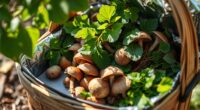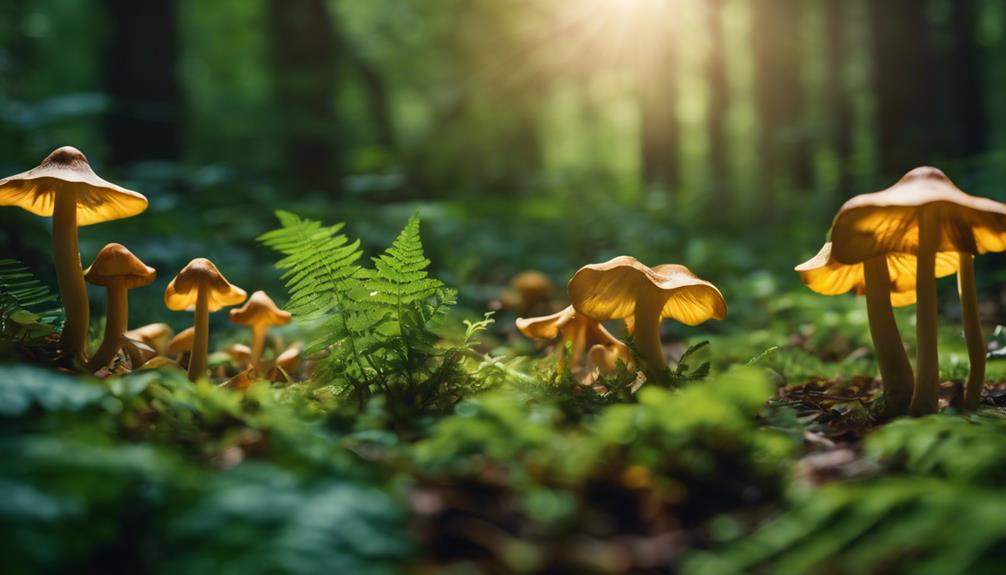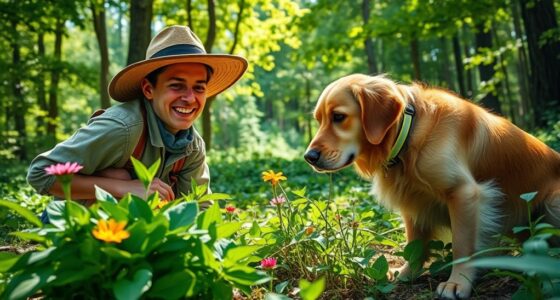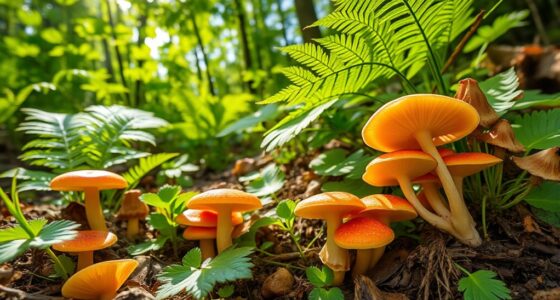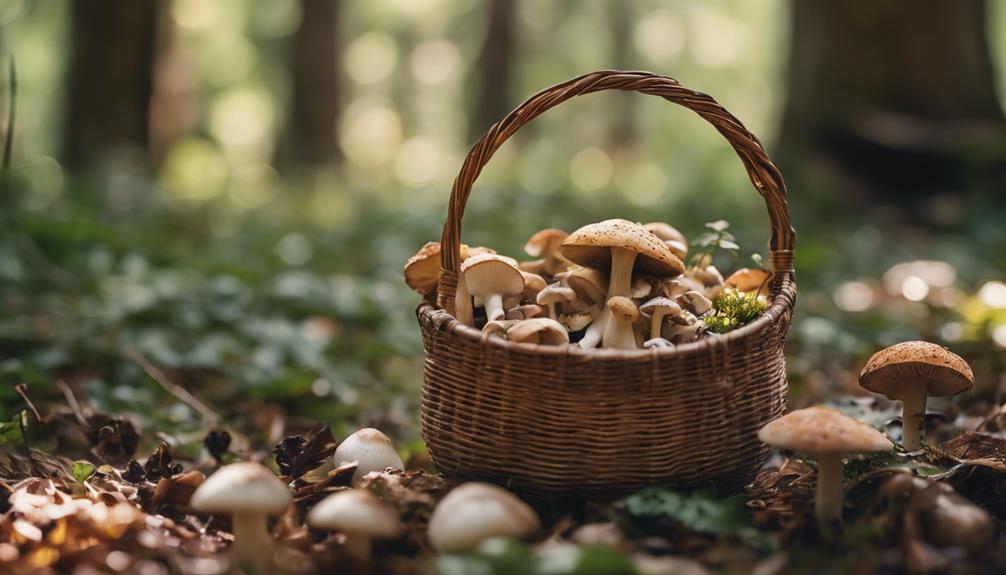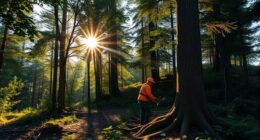To practice ethical harvesting and maximize flavor, use gentle, sustainable techniques that protect the environment. Only collect what’s ripe and necessary, avoiding overharvesting or uprooting plants. Follow local rules and respect protected zones to ensure ecosystems stay healthy. Use minimal impact methods, like cutting herbs instead of pulling roots, and leave no trace to preserve biodiversity. If you stay mindful, you’ll continue discovering ways to enjoy wild flavors responsibly.
Key Takeaways
- Use gentle cutting techniques to harvest herbs and greens, avoiding uprooting or damaging the plant.
- Only collect ripe, abundant resources, leaving enough for plant reproduction and future growth.
- Respect local regulations and protected areas to prevent ecological imbalance and support conservation efforts.
- Minimize soil disturbance and leave minimal trace by practicing careful, non-invasive gathering methods.
- Prioritize sustainable practices that preserve ecosystem health, ensuring flavors and resources are available long-term.
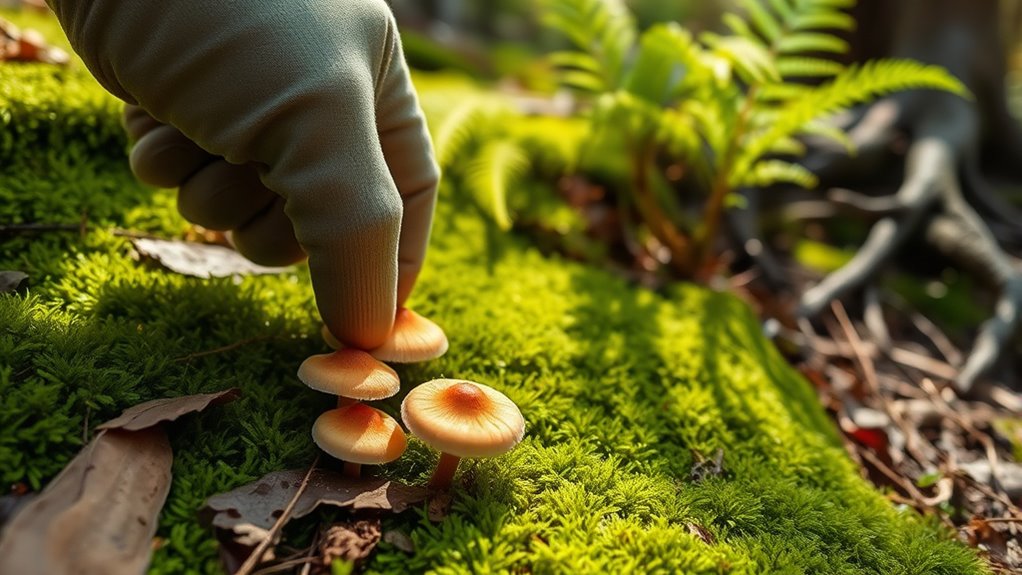
In today’s agricultural landscape, adopting ethical harvesting tactics is vital for maintaining sustainability and respecting both the environment and local communities. Whether you’re out in the wild foraging or harvesting from cultivated land, your goal should be to minimize your impact while maximizing the benefits of what you gather. Wild foraging, in particular, offers a chance to connect with nature and enjoy fresh, flavorful ingredients; however, it also requires a responsible approach to guarantee these resources remain available for future generations. Sustainable harvesting involves more than just collecting what’s needed — it’s about understanding the ecosystem, recognizing the abundance of certain species, and avoiding overharvesting.
Practice ethical foraging to preserve ecosystems and ensure future abundance of wild resources.
When you forage in the wild, always start by learning the local regulations and guidelines. Many areas have rules designed to protect vulnerable plant populations and prevent ecological imbalance. Respect these rules, and don’t take more than what you need. This practice guarantees that plants can regenerate and continue to thrive. For example, if you’re collecting berries, pick only what’s ripe and leave enough behind so the plants can reproduce. Similarly, when harvesting mushrooms or herbs, take only what is necessary and avoid damaging the surrounding flora. This careful approach exemplifies sustainable harvesting — gathering with the future in mind, not just immediate gratification.
Another vital aspect of ethical harvesting is avoiding damage to the environment. When you forage, use gentle techniques that prevent disturbing the soil, roots, or nearby plants. For instance, when harvesting herbs or leafy greens, cut rather than uproot the entire plant, allowing it to grow back. If you’re collecting woody parts like twigs or bark, do so sparingly. Remember, your goal is to leave as little trace as possible, aligning with the Leave No Trace principles. This mindset helps preserve biodiversity and the natural beauty of the areas you explore. Additionally, understanding the importance of sustainable harvesting practices can ensure you contribute positively to the ecosystem while enjoying the bounty of nature.
Frequently Asked Questions
How Do I Identify Sustainable Harvesting Locations?
To identify sustainable harvesting locations, you should look for areas near wildlife corridors, which support healthy ecosystems and biodiversity. Choose sites with well-preserved soil, indicating minimal disturbance and good soil preservation. Avoid fragile environments or overused spots. Visit areas during different seasons to assess plant health, and consult local guides or conservation groups for insights. By prioritizing these factors, you help make sure your harvesting practices support sustainability and ecological balance.
What Tools Are Best for Ethical Foraging?
Imagine gently prying a delicate mushroom from earth’s embrace, feeling connected to nature. You’ll want sharp, precise tools like a sturdy knife for plant identification and a small brush for cleaning. Keep your tools clean and well-maintained to avoid harming plants. A field guide or app helps with plant identification, ensuring sustainable harvesting. With care and proper tools, you preserve the landscape’s beauty while gathering what you need.
How Can I Ensure I Don’T Damage the Environment?
To avoid damaging the environment, focus on responsible plant propagation by selecting only mature plants and avoiding overharvesting. Use tools carefully to minimize soil disturbance, and always plan your harvest to preserve the plant’s ability to reproduce. Practice soil conservation by leaving enough plant material and roots behind, preventing erosion. Respect the ecosystem’s balance, and leave the area better than you found it to ensure sustainable foraging for future seasons.
Are There Legal Guidelines for Harvesting Wild Plants?
Think of this like steering through a labyrinth; you need to know the rules to avoid traps. Yes, there are legal regulations for harvesting wild plants, designed to protect plant conservation and guarantee sustainability. Before you gather, research local laws, permits, and restrictions. Following these guidelines helps you harvest responsibly while respecting nature’s balance. Ignoring them risks damage to ecosystems and legal trouble, so always stay informed and act ethically.
How Do I Harvest Without Disturbing Local Wildlife?
To harvest without disturbing wildlife, you should approach carefully and avoid disturbing their habitat. Stay on established paths, keep noise levels low, and avoid harvesting during sensitive times like nesting season. By respecting habitat preservation and giving wildlife space, you minimize disturbance. Always be mindful of your surroundings, and leave the environment as you found it, ensuring local animals continue to thrive without unnecessary stress or disruption.
Conclusion
By adopting these ethical harvesting tactics, you already make a difference. But there’s more to uncover—techniques that could change everything you thought you knew about sustainable foraging. Are you ready to explore deeper, to truly master the art of leaving no trace while gaining all the flavor? The next step awaits—are you prepared to take it? The future of ethical harvesting is in your hands, and the most surprising secrets are just beyond the horizon.


